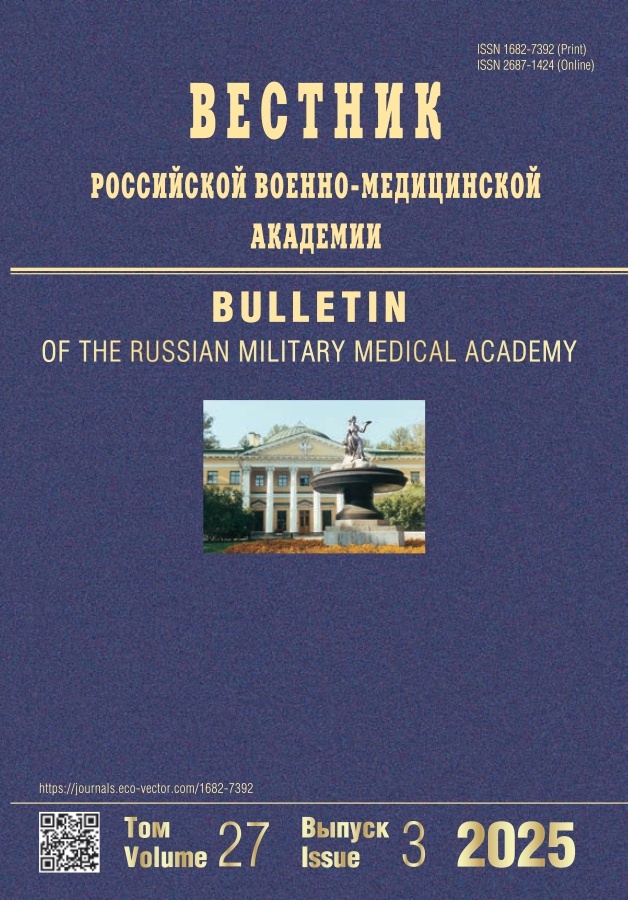The influence of glyprolins on the behavior of laboratory animals under experimental hyperthyroidism
- Authors: Sergalieva M.U.1, Tsibizova A.A.1, Abdulkadyrova E.I.1, Andreeva L.A.2, Samotrueva M.A.1, Myasoedov N.F.2
-
Affiliations:
- Astrakhan State Medical University
- Kurchatov Institute — Institute of Molecular Genetics
- Issue: Vol 23, No 4 (2021)
- Pages: 179-186
- Section: Experimental trials
- URL: https://journals.rcsi.science/1682-7392/article/view/66467
- DOI: https://doi.org/10.17816/brmma66467
- ID: 66467
Cite item
Abstract
This study aimed to determine the peculiarities of behavioral reactions and psychoemotional status of laboratory animals in experimental hyperthyroidism conditions against the background of introducing peptides of glyproline series (selank and tripeptide Pro-Gly-Pro). All experiments were conducted on white non-linear male rats, which were divided into groups consisting of 10 individuals. The first group consisted of control rats that received intraperitoneal water for injection in equi-volume. The second group consisted of individuals with experimental hyperthyroidism modeled by intragastric administration of L-thyroxine “Berlin-Chemi” Germany) at 150 mcg/kg/day for 21 days. The third and fourth groups were animals with a hyperthyroidism model and received intraperitoneal Selank and Pro-Gly-Pro at 200 mcg/kg/day for 21 days after the hyperthyroidism model development. The behavioral activity determination of laboratory animals was conducted using the “Open Field” method, which is widely used in the analysis of approximate research activity, locomotive stereotyping, and the emotional reactivity level of rodents. The level of animal anxiety was assessed using the Raised cross-shaped maze method. The study revealed that experimental hyperthyroidism due to the introduction of L-thyroxine is accompanied by an increased level of the anxiety-depressive state in the behavior of male rats. The study on the effects of selank and its structural analog Pro-Gly-Pro on the psychoemotional status of male rats using Open Field and Raised cruciform labyrinth methods revealed that the recovery of the approximate research motor activity of laboratory animals is noted, which indicates the psychomodulatory activity of glyproline neuropeptides, in experimental hyperthyroidism conditions.
Full Text
##article.viewOnOriginalSite##About the authors
Mariyam U. Sergalieva
Astrakhan State Medical University
Author for correspondence.
Email: charlina_astr@mail.ru
ORCID iD: 0000-0002-9630-2913
SPIN-code: 7976-9321
candidate of biological sciences
Russian Federation, AstrakhanAlexsandra A. Tsibizova
Astrakhan State Medical University
Email: sasha3633@yandex.ru
ORCID iD: 0000-0002-9994-4751
SPIN-code: 2206-3898
candidate of pharmaceutical sciences
Russian Federation, AstrakhanElvira I. Abdulkadyrova
Astrakhan State Medical University
Email: elvira_abdulkadyrova@mail.ru
graduate student
Russian Federation, AstrakhanLudmila A. Andreeva
Kurchatov Institute — Institute of Molecular Genetics
Email: landr@img.ras.ru
ORCID iD: 0000-0002-3927-8590
SPIN-code: 4785-5621
sector manager
Russian Federation, MoscowMarina A. Samotrueva
Astrakhan State Medical University
Email: ms1506@mail.ru
ORCID iD: 0000-0001-5336-4455
SPIN-code: 5918-1341
doctor of medical sciences, professor
Russian Federation, AstrakhanNikolay F. Myasoedov
Kurchatov Institute — Institute of Molecular Genetics
Email: nfm@img.ras.ru
ORCID iD: 0000-0003-1294-102X
SPIN-code: 1262-2698
doctor of chemical sciences, professor
Russian Federation, MoscowReferences
- Samotrueva MA, Sergalieva MU, Tsibizova AA, et al. Diabetes mellitus as a consequence of neuroimmunoendocrine disorders. Humans and their health. 2020;(2):57–64. (In Russ.). doi: 10.21626/vestnik/2020-2/08
- Bashkina OA, Samotrueva MA, Azhikova AK, et al. Neuroimmunoendocrine regulation of physiological and pathophysiological processes in the skin. Meditsinskaya immunologiya. 2019;21(5): 807–820. (In Russ.). doi: 10.15789/1563-0625-2019-5-807-820
- Taams LS. Neuroimmune interactions: how the nervous and immune systems influence each other. Clinical and Experimental Immunology. 2019;197(3):276–277. doi: 10.1111/cei.13355
- Kanaev RA, Kudaibergenova ME. Neuroendocrine immune disorders in thyroid diseases. Vestnik nauki i obrazovanija. 2017;1(5):99–103. (In Russ.)
- Salazar P, Cisternas P, Martinez M, et al. Hypothyroidism and Cognitive Disorders during Development and Adulthood: Implications in the Central Nervous System. Molecular Neurobiology. 2019;56(4):2952–2963. doi: 10.1007/s12035-018-1270-y
- Demin DB. Effects of thyroid hormones in the development of the nervous system (review). Zhurnal mediko-biologicheskih issledovanij. 2018;6(2):115–127. (In Russ.). doi: 10.17238/issn2542-1298.2018.6.2.115
- Askaryants VP, Akhrorov KhKh, Mustakimova FA. Influence of thyroid hormones on the nervous system. Medicus. 2018;(1):11–13. (In Russ.).
- Gorobets LN, Ivanova GP, Litvinov AV, et. al. Mental disorders in endocrine diseases. Psikhicheskie rasstroystva v obshchey meditsine. 2018;(1):31–36. (In Russ.).
- Becker RA, Bykov YuV. On the role of neuroendocrine disorders in the pathogenesis of cognitive dysfunction in depressive states (literature review with comments). Consilium medicum. 2016;18(4):57–61. (In Russ.).
- Grigorieva EA, Pavlova EA. Depression and thyrotoxicosis. Sotsial’naya i klinicheskaya psikhiatriya. 2010;20(2):100–107. (In Russ.).
- Gromova DS. Study of behavioral reactions and memory functions of white rats under the influence of various types of stress and the possibility of their correction with the nootropic drug "Semax". Vestnik meditsinskogo instituta REAVIZ. 2011;(3):49–52. (In Russ.).
- Gusakova EA, Gorodetskaya IV. Influence of small doses of L-thyroxine on the resistance to stress of animals with experimentally induced deficiency of sympathetic nervous influences. Rossiyskiy fiziologicheskiy zhurnal im IM. Sechenova. 2021;107(3):352–373. (In Russ.). doi: 10.31857/S0869813921030067
- Kost NV, Meshavkin VK, Zozulya AA. Neuropeptides in the regulation of anxiety. Psychiatry (Moscow). 2010;4(46):64–75. (In Russ.).
- Kanunnikova NP. Neuroprotective properties of neuropeptides. Zhurnal Grodnenskogo gosudarstvennogo meditsinskogo universiteta. 2017;15(5):492–498. (In Russ.). doi: 10.25298/2221-8785-2017-15-5-492-498
- Hallberg M. Neuropeptides: metabolism to bioactive fragments and the pharmacology of their receptors. Medicinal Research Reviews. 2015;35(3):464–519. doi: 10.1002/med.21323
- Muratalieva VH. Semax as a corrector of changes in the blood system in experimental depression. Farmatsiya. 2018;(S): 105–106. (In Russ.).
- Strezhdova EV, Novikov VE. Pharmacodynamics and clinical use of ACTH4-10 neuropeptide. Vestnik of the Smolensk State Medical Academy. 2020;19(3):76–86. (In Russ.). doi: 10.37903/vsgma.2020.3.10
- Slominsky PA, Shadrina MI, Kolomin TA, et al. Peptides semax and selank affect the behavior of rats with 6-OHDA induced PD-like parkinsonism. Doklady Biological Sciences. 2017;474(1): 106–109. doi: 10.1134/S0012496617030048
- Yu D, Zhou H, Yang Y, et al. The bidirectional effects of hypothyroidism and hyperthyroidism on anxiety- and depression-like behaviors in rats. Hormones and Behavior. 2015;69:106–115. doi: 10.1016/j.yhbeh.2015.01.003
- Mendoza A, Hollenberg AN. New insights into thyroid hormone action. Pharmacol Ther. 2017;173:135–145. doi: 10.1016/j.pharmthera.2017.02.012
- Liu YY, Brent GA. Thyroid hormone and the brain: Mechanisms of action in development and role in protection and promotion of recovery after brain injury. Pharmacol Ther. 2018;186:176–185. doi: 10.1016/j.pharmthera.2018.01.007
- Prikaz Ministerstva zdravoohraneniya Rossiiskoi Federacii № 199n ot 1 aprelya 2016 g. «Ob utverjdenii Pravil laboratornoi praktiki». Moscow; 2016. 6 p. (In Russ.) Available from: https://normativ.kontur.ru/document?moduleId=1&documentId=278397
- GOST 33215-2014 "Rukovodstvo po soderzhaniyu i ukhodu za laboratornymi zhivotnymi". Moscow; 2014. 11 p. (In Russ.). Available from: https://docs.cntd.ru/document/1200127789
Supplementary files














